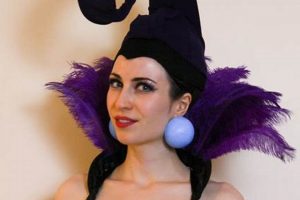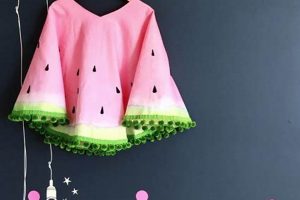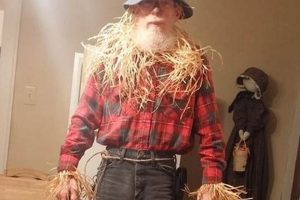The creation of avian-inspired attire through do-it-yourself methods offers a personalized and often cost-effective alternative to commercially produced options. Such endeavors typically involve utilizing readily available materials and individual creativity to construct garments that mimic the appearance of various avian species. For example, individuals might fashion wings from cardboard and feathers or create a beak from felt to achieve the desired aesthetic.
Engaging in the construction of handcrafted avian representations promotes resourcefulness, allows for unique expressions of personal style, and provides an opportunity to learn about different bird species. Historically, self-made garments have been employed in theatrical productions, celebrations, and educational activities, offering a tangible and engaging method for individuals to connect with the natural world and embody aspects of avian characteristics.
The subsequent sections will explore specific techniques for crafting individual components, detailing various material choices, and outlining approaches for assembling full-body representations. Emphasis will be placed on safety considerations and adaptability for diverse age groups and skill levels, enabling the creation of distinctive and memorable avian-themed ensembles.
Tips for Crafting Avian-Inspired Garb
The following guidelines aim to assist in the successful creation of avian-themed attire. Attention to detail and careful material selection are crucial for achieving a convincing and durable result.
Tip 1: Planning is Paramount: Before commencing, create a detailed sketch or blueprint. This visual aid should include specific bird species inspiration, material choices, and a scale representation of the design. Precise planning mitigates errors and facilitates efficient construction.
Tip 2: Feather Procurement and Application: Natural feathers, when ethically sourced, enhance realism. However, synthetic options provide durability and consistent aesthetics. Attach feathers securely using appropriate adhesives or stitching techniques to prevent detachment during wear.
Tip 3: Wing Structure Integrity: The wing structure must be lightweight yet sturdy. Cardboard, foam board, or wire frames offer viable support. Ensure adequate reinforcement at attachment points to the wearers body for comfortable and secure wear.
Tip 4: Beak Construction and Attachment: The beak should accurately reflect the chosen bird species. Moldable materials such as polymer clay or felt allow for customization. Secure attachment to a headband or mask is recommended for stability and comfort.
Tip 5: Color Palette Consistency: Maintain a consistent color scheme throughout the project. Research the natural plumage of the target bird species to select appropriate hues and patterns. Employ fabric dyes or paints to achieve accurate representations.
Tip 6: Safety Considerations: Prioritize safety by using non-toxic materials and avoiding sharp edges or protrusions. Ensure adequate visibility for the wearer, particularly in areas around the eyes and face.
Tip 7: Size and Proportionality: Adjust the scale of the outfit to suit the wearer’s dimensions. Disproportionate elements can detract from the overall aesthetic. Pay particular attention to wing span relative to body size.
Adhering to these guidelines increases the likelihood of creating a visually appealing and functional garment. Thoughtful execution elevates the outcome, resulting in a realistic and memorable representation.
The subsequent section will address advanced construction techniques and customization options for achieving professional-quality results.
1. Feather Realism
Feather realism constitutes a pivotal aspect in the successful execution of avian-inspired attire construction. The degree to which the constructed feathers mimic natural plumage directly influences the overall verisimilitude and impact of the bird representation.
- Material Selection and Texture Replication
The choice of materials profoundly affects the perceived realism. Employing materials that emulate the texture, sheen, and flexibility of natural feathers is crucial. Options range from ethically sourced natural feathers to synthetic alternatives such as high-quality faux feathers, fabric cutouts designed to mimic feather patterns, or even layered paper or plastic elements. The selection process should consider the specific type of bird being emulated, as plumage characteristics vary significantly across avian species.
- Color Gradient and Patterning Techniques
Natural feathers exhibit intricate color gradients and patterns. Replicating these nuances requires careful attention to detail. Techniques such as airbrushing, hand-painting, or the strategic layering of different colored materials can effectively simulate the subtle variations found in real plumage. Accurate representation of patterns, such as barring, speckling, or iridescent sheens, further enhances the sense of realism.
- Feather Arrangement and Layering Methodologies
The manner in which feathers are arranged and layered significantly impacts the overall aesthetic. Mimicking the natural imbrication and overlap of feathers is essential for creating a convincing representation. Overlapping rows of feathers, secured strategically, create volume and depth. Consideration must be given to the orientation and angle of each feather to accurately reflect the natural contours of avian plumage.
- Durability and Structural Integrity Considerations
While aesthetic realism is paramount, durability and structural integrity remain vital. The constructed feathers must withstand the rigors of wear and movement without significant degradation. Reinforcing delicate materials, employing robust attachment methods, and selecting weather-resistant options contribute to the longevity of the feathered components. The balance between realism and practicality must be carefully considered throughout the construction process.
The concerted application of these facets enhances the realism of the feathered elements, elevating the overall impact of the avian-inspired attire. The success of any such undertaking hinges on a meticulous approach to material selection, coloration, arrangement, and structural support, all contributing to a believable and visually striking bird representation.
2. Wing Span
Wing span represents a critical dimension in avian morphology, directly impacting flight capabilities and visual identification. In the context of crafting avian-inspired attire, wing span becomes a salient element influencing the overall realism and aesthetic impact of the piece. An accurately scaled wing span contributes significantly to the recognizability of the intended bird species, whereas a disproportio
nate rendition can detract from the authenticity of the design. For instance, constructing an eagle representation necessitates a significantly larger wing span compared to that of a hummingbird, accurately reflecting the natural size differences between these species. The selection of materials, structural design, and attachment methods are all influenced by the desired wingspan. An inappropriately sized wing span can affect the wearer’s mobility and balance and reduce visual accuracy.
The practical application of understanding wing span extends to considerations of costume functionality and wearability. A large wing span, while visually impressive, may impede movement in confined spaces, necessitating a design that allows for wing retraction or adjustability. Furthermore, structural support becomes increasingly crucial as wing span increases, requiring robust materials and secure attachment points to prevent sagging or detachment. The angle and curvature of the wing, also factors related to wing span considerations, impact aerodynamic accuracy and visual appeal. Real-world examples include theatrical productions where carefully engineered wing structures allow performers to realistically mimic flight patterns, or educational displays using anatomically accurate avian representations for illustrative purposes.
In summary, accurate wing span is a crucial component in achieving realism and functionality in avian-inspired attire. Challenges include balancing visual accuracy with wearability and structural integrity. Understanding the relationship between wing span and avian species characteristics allows for informed design choices, ultimately contributing to a more compelling and credible final product. The size and shape of the wings are important, as they impact both visual accuracy and the wearer’s comfort and mobility. Failing to account for wing span leads to inaccurate renditions.
3. Beak Accuracy
Beak accuracy constitutes a crucial element in the construction of avian-inspired attire. It is a defining characteristic that significantly contributes to the recognizability and realism of the finished product. Discrepancies in beak shape, size, or color can detract from the overall impact, potentially rendering the representation inaccurate or unconvincing. Therefore, meticulous attention to beak morphology is paramount.
- Species-Specific Morphology
Avian beaks exhibit remarkable diversity, with each species possessing a beak uniquely adapted to its dietary needs and ecological niche. The long, slender beak of a hummingbird contrasts sharply with the powerful, hooked beak of a raptor, or the sieve-like beak of a filter-feeding duck. Accurately replicating these species-specific features is essential. For example, attempting to depict a toucan without accurately rendering its large, colorful beak would result in an immediately recognizable and critical flaw.
- Material Selection and Construction Techniques
The choice of materials directly impacts the feasibility of achieving accurate beak representation. Moldable materials such as polymer clay or foam allow for intricate shaping and detailing, while rigid materials like plastic or wood may offer greater durability. Construction techniques should accommodate the complexities of beak structure, potentially involving multi-part assemblies or the use of specialized tools for carving or shaping. Consider the curvature and contours of the beak. Also, consider if it is one piece or if it is multi-part assembly.
- Coloration and Textural Details
Beaks often display intricate coloration patterns and textural features that contribute to species identification. Simulating these details requires precise application of paints, dyes, or other coloring agents. Consider the glossy surface of a raven’s beak or the subtle variations in color found on a parrot’s beak. Textural elements, such as ridges or grooves, can be replicated through sculpting or embossing techniques.
- Attachment and Integration with Overall Design
The method of attachment and integration of the beak with the rest of the costume significantly impacts both visual appeal and wearability. Secure and stable attachment is crucial to prevent detachment during wear. The beak should seamlessly integrate with the overall design, maintaining proper proportions and alignment with other avian features. Consider a harness or frame that can hold the beak steadily and consistently.
The successful integration of these facets significantly elevates the realism and impact of avian-inspired attire. By accurately representing beak morphology, coloration, and texture, the resulting creation becomes a more compelling and recognizable representation of the intended bird species. Beaks must be carefully considered and deliberately constructed as each species has a unique design.
4. Color Palette
The selection of a color palette is a determinant factor in the success of any avian-inspired, do-it-yourself garment. The verisimilitude and recognizability of the intended bird species depend heavily on the accurate representation of its plumage coloration. Discrepancies in color can significantly diminish the overall impact, rendering the finished product less convincing. For example, a robin is instantly recognizable by its distinctive red breast; omitting or misrepresenting this color would undermine the costume’s authenticity.
Furthermore, the correct color palette extends beyond simply matching the dominant hues. It necessitates considering subtle variations, gradients, and patterns present in the natural plumage. The iridescent sheen on a raven’s feathers, the delicate barring on a falcon’s wings, and the intricate color patterns on a peacock’s tail all demand careful attention to detail. Practical application involves utilizing techniques such as fabric dyeing, painting, or selective material choices to achieve the desired effects. Knowledge of color theory, including complementary and analogous color schemes, aids in creating visually appealing and realistic representations. Using different textures and types of materials also add complexity.
In conclusion, the strategic implementation of an accurate color palette is essential for realizing a convincing avian-inspired DIY garment. This process requires meticulous research, careful material selection, and precise application techniques. Challenges include accurately matching colors, recreating complex patterns, and ensuring colorfastness. However, the effort invested in achieving color fidelity directly translates to a more visually compelling and recognizable avian representation. Careful attention to color is a prerequisite, not an afterthought, to a successfully realized design.
5. Wearability
Wearability, in the context of avian-inspired do-it-yourself attire, constitutes a fundamental consideration directly influencing the success and practicality of the created piece. The aesthetic realism and artistic merit of a bird diy costume are inherently compromised if the item is uncomfortable, restrictive, or unsafe to wear. For instance, wings constructed from overly heavy materials may cause strain and discomfort, preventing extended use. S
imilarly, a beak that obstructs vision or breathing renders the entire ensemble impractical, regardless of its visual accuracy. The interplay between design, materials, and construction techniques directly determines the ultimate wearability of the costume.
Practical applications of optimizing wearability involve careful attention to factors such as weight distribution, range of motion, and ventilation. Lightweight materials, strategically placed support structures, and adjustable fastenings contribute to enhanced comfort and mobility. Consider, for example, a costume designed for a child’s school play; it must allow for unrestricted movement during performance while remaining securely in place. Furthermore, costumes intended for outdoor events necessitate consideration of weather conditions, requiring breathable fabrics and protection from the elements. Neglecting these aspects diminishes the usability of the costume. Another consideration is the need to have safety features that may be useful if the costume is worn in public.
In summary, wearability is not merely an ancillary concern but an integral component of successful avian-inspired DIY attire. A balance between aesthetic design and practical considerations is crucial for ensuring that the resulting costume is not only visually appealing but also comfortable, safe, and functional. Overlooking wearability compromises the potential enjoyment and effectiveness of the costume, ultimately undermining the creative effort invested in its construction. The functionality is important, not only the visual accuracy.
Frequently Asked Questions
The following section addresses common inquiries and concerns regarding the creation of avian-themed garments, providing concise and informative responses to frequently posed questions.
Question 1: What are the primary considerations when selecting materials for constructing wings?
Material selection for wing construction should prioritize lightweight durability. Options include, but are not limited to, reinforced cardboard, foam board, and lightweight fabrics stretched over wire frames. The selected material should be able to maintain its shape and withstand repeated use without causing undue strain on the wearer. Weight distribution must also be considered to avoid imbalance or discomfort.
Question 2: How can realistic feather textures be achieved using synthetic materials?
Achieving realistic feather textures with synthetic materials involves employing techniques such as layering different fabrics, using textured paints, and strategically applying heat to create subtle curves and contours. The use of specialized cutting tools can also aid in creating feather-like shapes and edges. Experimentation with various methods is recommended to achieve the desired aesthetic.
Question 3: What are the safest methods for attaching a beak to a facial covering?
Attaching a beak to a facial covering requires careful consideration of safety and comfort. Secure attachment methods include using non-toxic adhesives specifically designed for fabric or plastic, as well as incorporating adjustable straps or elastic bands to ensure a snug and stable fit. Avoid using sharp or pointed attachment mechanisms that could pose a risk of injury.
Question 4: How can wearability be optimized in a full-body avian garment?
Optimizing wearability in a full-body avian garment requires careful attention to weight distribution, ventilation, and range of motion. Incorporating breathable fabrics, adjustable closures, and strategically placed openings can enhance comfort and mobility. Regular fittings during the construction process are recommended to ensure a proper fit and identify any potential areas of discomfort.
Question 5: What are the ethical considerations regarding the use of natural feathers in attire construction?
The use of natural feathers in attire construction raises ethical concerns related to animal welfare and environmental sustainability. It is recommended to source feathers from reputable suppliers who adhere to ethical and humane practices. Alternatively, consider using synthetic alternatives that mimic the appearance of natural feathers without contributing to the exploitation of avian species.
Question 6: How can colorfastness be ensured when dyeing fabrics for avian-inspired attire?
Ensuring colorfastness when dyeing fabrics involves using high-quality dyes specifically designed for the target fabric type and following the manufacturer’s instructions carefully. Pre-washing the fabric to remove any sizing or finishes can also improve dye absorption. After dyeing, thoroughly rinse the fabric and use a color fixative to prevent bleeding or fading. Testing a small swatch of fabric is recommended before dyeing the entire piece.
The preceding responses provide a foundation for addressing common concerns related to the construction of avian-inspired attire. Adhering to these guidelines can enhance the safety, comfort, and aesthetic quality of the finished product.
The subsequent section will delve into specific design considerations and customization options for creating unique and personalized avian representations.
Conclusion
This exploration has elucidated critical facets of “bird diy costume” creation, emphasizing the significance of feather realism, accurate wing span, beak morphology, color palette fidelity, and overall wearability. A comprehensive understanding of avian anatomy and plumage characteristics, coupled with meticulous material selection and construction techniques, is essential for successful execution.
The creation of effective avian-inspired attire requires a commitment to detail and a thorough understanding of the principles outlined. Future endeavors should prioritize sustainable material sourcing and innovative construction methods to minimize environmental impact. Continued exploration and refinement of these techniques will undoubtedly yield increasingly realistic and compelling representations of the avian world.







